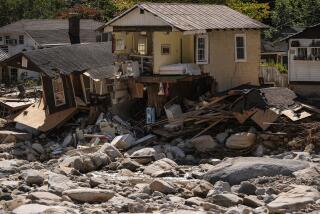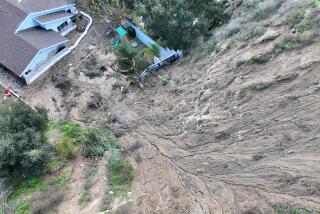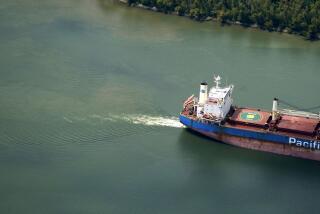Fortified levees may not be strong enough for onslaught
- Share via
As Hurricane Gustav bore down Sunday on New Orleans, top officials at the Army Corps of Engineers said that despite repairs and reinforcements, the 350-mile levee system still might not be able to fully protect the city.
The earth and concrete levees are stronger and higher than when Hurricane Katrina struck three years ago, but they would still be unable to resist a storm of the same size.
“It all depends on the strength of the storm, in terms of wind speed, water surge and how fast the hurricane tracks,” Maj. Gen. Don T. Riley, deputy chief of the corps, said in an interview. “There are still vulnerabilities. There are gaps in the system.”
If Gustav hits the city with a large surge, the levees could be too low to prevent flooding, particularly in Gentilly, St. Bernard Parish and the 9th Ward, all neighborhoods that were partially or completely flooded three years ago.
After Katrina, the corps made emergency repairs to about 150 miles of damaged or destroyed levees and upgraded about 70 more miles of levees.
In addition, Congress has authorized programs totaling almost $15 billion to upgrade the entire system by 2011. But that project is only 25% complete.
Federal officials say Gustav has the potential to inflict serious damage, and must be taken seriously. As of Sunday evening, the National Hurricane Center said the storm was “extremely dangerous” and would produce a 10- to 14-foot surge of water, down from an earlier prediction of 15 to 25 feet.
Like Katrina, Gustav has a large diameter and is aiming at the Louisiana coast. It appeared Sunday that the storm was tracking to the west of New Orleans, where it would exert the greatest pressure on the low-lying communities to the south of downtown New Orleans. This area west of the Mississippi River, known to locals as the West Bank, escaped devastating flood damage three years ago. The Army Corps’ levee rebuilding program is less complete in this area than in others.
After Katrina, the corps was harshly criticized by experts who said it had repeatedly miscalculated the strength of its levees and was bungling the repairs. Some of the greatest failures involved concrete storm walls lining drainage canals used to pump water from areas of the city below sea level.
Rather than rebuild miles of suspect storm walls, the corps built barrier gates at the mouths of drainage canals at Lake Pontchartrain and installed massive pumps to move flood water from the canals into the lake. The quality and testing of the pumps grew into a major scandal, but corps officials say the system is now fully tested and ready for action.
“Despite those ongoing controversies, we have tested those pumps again and again,” said Karen Durham-Aguilera, director of Task Force Hope, the corps program to build a stronger protection system.
The corps has also raised levees throughout the system. Along Lake Pontchartrain, for example, levees are now about 17 feet above sea level, compared with 14 feet before Katrina, said Ed Link, a University of Maryland professor who led the post-Katrina investigation.
“Right now, the city in general is better protected, but it is still not adequate,” Link said.
During Katrina, the Industrial Canal breached and flooded the 9th Ward when the storm surge moved up the Mississippi River-Gulf Outlet and struck the heart of the city. Despite repairs, its storm walls remain a weak point.
In recent weeks, the corps rushed to shore up a section of concrete wall on the Industrial Canal after corps members noted design weaknesses. Three-thousand-pound baskets of sand were brought in to reinforce the wall.
“The system is only as good as the weakest point,” Durham-Aguilera said.
The corps has a plan to build large barriers along the canal, similar to those used in the Netherlands, said Durham-Aguilera. It awarded a $700-million contract earlier this year, but the structure will not be completed until 2011.
Long sections of levees along the Mississippi River-Gulf Outlet were washed away during Katrina. Corps officials say those sections, rebuilt with clay soils more resistant to erosion, are much stronger.
Not everybody accepts the corps’ word.
Some critics have long contended that the corps used weak soils to rebuild levees and has taken other shortcuts. Corps officials acknowledged that their engineering failures had contributed to at least half the flooding that destroyed much of New Orleans.
Even though Katrina was a Category 3 storm in terms of wind speed, it produced a surge that would be expected, statistically, once every 396 years. The official corps investigation into Katrina concluded it was the biggest ocean surge to hit North America in recorded history.
The federal upgrade program is supposed to give the city protection against storms that have a 1% probability of hitting in any given year, or roughly once every 100 years.
But the probability figures may give the public a false assurance. The key issue is whether the public understands the forces of nature it is up against, said Gerry Galloway, a levee expert at the University of Maryland.
“The idea that we are telling people in New Orleans that they have a 100-year level of protection and that they should feel safe is not going to do any good,” Galloway said. “The idea that they are safe is not right.”
Sandy Rosenthal, founder of Levees.Org, has consistently criticized the corps for its investigation of Katrina and its assurances to the public.
“I was scared to death when I heard the storm was coming,” Rosenthal said. She evacuated with her family to Baton Rouge, La.
Although she wishes the corps had moved faster to improve protection in the city, she said, “It looks to me like they are working very hard. There is a political will in Congress to fix the system.”
Durham-Aguilera said the corps was trying to get out the message that it could not provide any absolute assurances.
“Whether you are dealing with wild fires or hurricanes or earthquakes,” she said, “there is no such thing as a guarantee against risk. “
--
ralph. vartabedian@ latimes.com
--
Times staff writer Richard A. Serrano contributed to this report.
More to Read
Sign up for Essential California
The most important California stories and recommendations in your inbox every morning.
You may occasionally receive promotional content from the Los Angeles Times.











